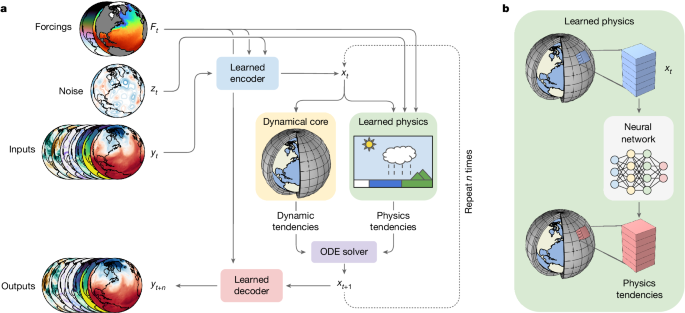Hybrid Neural-Physics Models for Accurate Weather and Climate Forecasting
Core Concepts
Hybrid neural-physics models can generate accurate weather and climate forecasts, offering significant computational savings over conventional physics-based general circulation models.
Abstract
The content discusses the development of a novel general circulation model (GCM) that combines a differentiable solver for atmospheric dynamics with machine learning components. This "NeuralGCM" model is shown to be competitive with both state-of-the-art machine learning models and physics-based GCMs for various weather and climate forecasting tasks.
Key highlights:
- NeuralGCM can generate accurate deterministic weather forecasts, ensemble weather forecasts, and long-term climate simulations, on par with the best existing methods.
- For one- to ten-day weather forecasts, NeuralGCM performs comparably to leading machine learning models.
- For one- to fifteen-day weather forecasts, NeuralGCM matches the skill of the European Centre for Medium-Range Weather Forecasts ensemble prediction system.
- With prescribed sea surface temperature, NeuralGCM can accurately track climate metrics for multiple decades and simulate emergent phenomena like tropical cyclones.
- The hybrid neural-physics approach offers orders of magnitude computational savings over conventional GCMs, although it does not extrapolate to substantially different future climates.
- The results demonstrate the potential of end-to-end deep learning to enhance large-scale physical simulations for understanding and predicting the Earth system.
Customize Summary
Rewrite with AI
Generate Citations
Translate Source
To Another Language
Generate MindMap
from source content
Visit Source
www.nature.com
Neural general circulation models for weather and climate - Nature
Stats
"GCMs are the foundation of weather and climate prediction1,2."
"Recently, machine-learning models trained on reanalysis data have achieved comparable or better skill than GCMs for deterministic weather forecasting3,4."
"NeuralGCM is competitive with machine-learning models for one- to ten-day forecasts, and with the European Centre for Medium-Range Weather Forecasts ensemble prediction for one- to fifteen-day forecasts."
"For both weather and climate, our approach offers orders of magnitude computational savings over conventional GCMs."
Quotes
"Here we present a GCM that combines a differentiable solver for atmospheric dynamics with machine-learning components and show that it can generate forecasts of deterministic weather, ensemble weather and climate on par with the best machine-learning and physics-based methods."
"With prescribed sea surface temperature, NeuralGCM can accurately track climate metrics for multiple decades, and climate forecasts with 140-kilometre resolution show emergent phenomena such as realistic frequency and trajectories of tropical cyclones."
"Our results show that end-to-end deep learning is compatible with tasks performed by conventional GCMs and can enhance the large-scale physical simulations that are essential for understanding and predicting the Earth system."
Key Insights Distilled From
by Dmitrii Koch... at www.nature.com 07-22-2024
https://www.nature.com/articles/s41586-024-07744-y
Deeper Inquiries
How can the hybrid neural-physics approach be further improved to extrapolate to substantially different future climate conditions?
To enhance the hybrid neural-physics approach for extrapolating to significantly different future climate conditions, several strategies can be implemented. Firstly, incorporating more comprehensive physical processes and feedback mechanisms into the machine-learning components can improve the model's ability to capture complex interactions within the Earth system. Additionally, increasing the diversity and quality of training data, including historical climate data and scenarios of potential future climate states, can help the model learn to generalize beyond the range of observed conditions. Furthermore, refining the neural network architecture to handle extreme events and non-linear responses in the climate system can enhance the model's capacity to simulate novel climate scenarios accurately. Collaborative efforts between climate scientists, machine learning experts, and domain specialists are crucial to iteratively refine and validate the hybrid model for robust extrapolation to substantially different future climate conditions.
What are the potential limitations or drawbacks of relying on machine learning components within a GCM, and how can these be addressed?
While integrating machine learning components into GCMs offers promising advancements in weather and climate prediction, several limitations and drawbacks need to be considered. One key challenge is the interpretability of machine learning models, as complex neural networks may lack transparency in explaining the underlying physical processes driving the predictions. Addressing this issue requires developing techniques for model explainability and uncertainty quantification to enhance the trustworthiness of the results. Moreover, the potential overfitting of machine learning models to training data poses a risk of reduced generalization performance, especially when extrapolating to novel climate conditions. Regularization methods, ensemble learning approaches, and data augmentation techniques can mitigate overfitting and improve the model's robustness. Additionally, ensuring the seamless integration of machine learning components with the physics-based solver in GCMs is essential to maintain the consistency and accuracy of the simulations. Continuous validation against observational data and benchmarking against traditional GCMs can help identify and rectify any discrepancies or biases introduced by the machine learning components.
What other complex physical systems, beyond weather and climate, could benefit from a similar hybrid modeling approach that combines machine learning with first-principles physics?
The hybrid modeling approach that combines machine learning with first-principles physics can be extended to various other complex physical systems beyond weather and climate, offering valuable insights and predictive capabilities. One potential application lies in astrophysics, where modeling the dynamics of celestial bodies, galaxy formation, and gravitational interactions could benefit from the synergy between machine learning algorithms and fundamental physical laws. Similarly, in geophysics, understanding seismic activities, plate tectonics, and geological processes could be enhanced by integrating machine learning techniques with domain-specific knowledge. Furthermore, the field of fluid dynamics, encompassing aerodynamics, ocean currents, and turbulence modeling, stands to gain from the hybrid approach to simulate intricate flow patterns and phenomena. Additionally, interdisciplinary domains such as materials science, quantum mechanics, and biological systems could leverage the hybrid modeling framework to unravel complex behaviors and optimize predictive capabilities. By adapting and customizing the hybrid modeling paradigm to diverse physical systems, researchers can unlock new avenues for exploration, discovery, and innovation across scientific disciplines.
0
